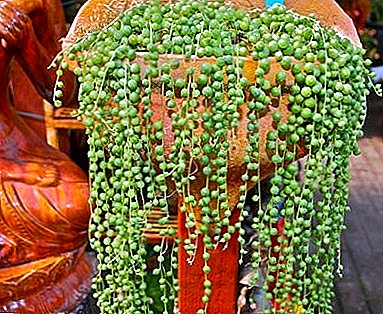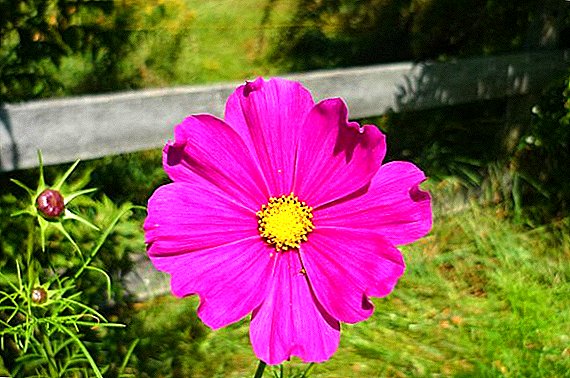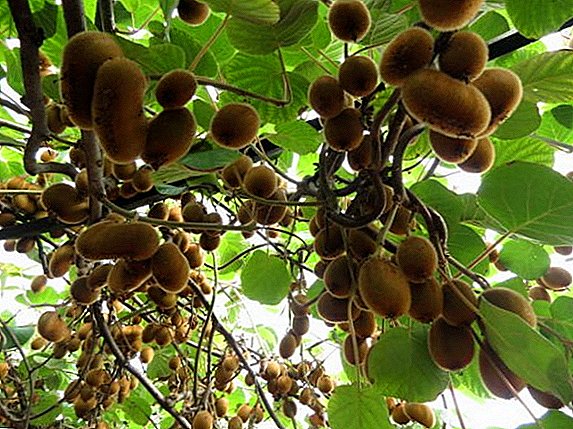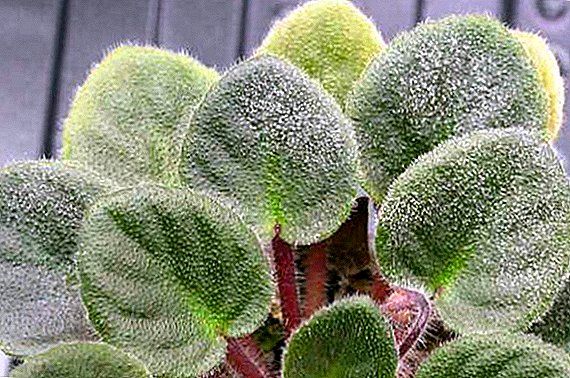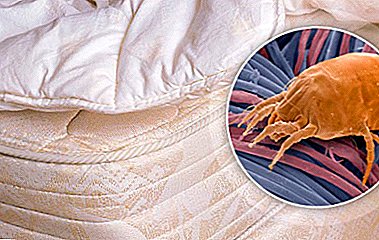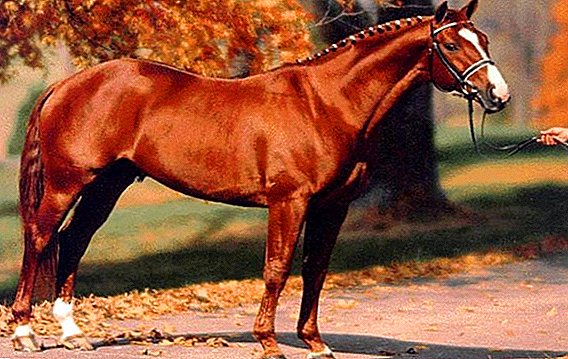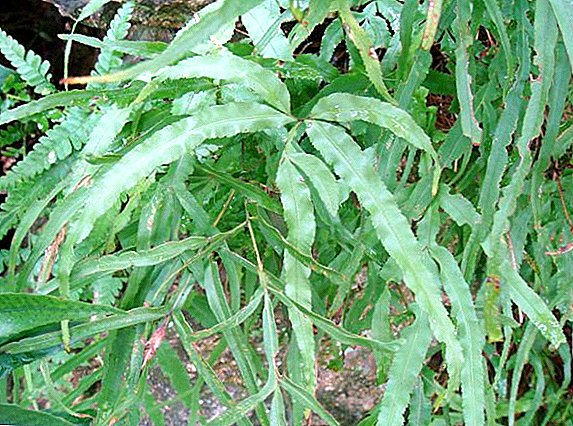 Ferns are one of the most amazing plants in the world: they have been living on Earth for more than 300 million years, have adapted to the most diverse climatic conditions (there are more than 12 thousand different ferns), have a decorative appearance and have useful properties.
Ferns are one of the most amazing plants in the world: they have been living on Earth for more than 300 million years, have adapted to the most diverse climatic conditions (there are more than 12 thousand different ferns), have a decorative appearance and have useful properties.
Pteris occupies a special place among ferns, as this large and beautiful plant will appeal both to inexperienced gardeners (caring for a plant at home is simple) and to sophisticated flower lovers.
Did you know? The name "pteris" comes from the Greek "pteron" - "wing of a bird". Leaf-like shoots (fronds) resemble wings, and if you cut the rhizome of this fern acrossit can be seen that the bundles of vessels are arranged in the form of a pattern that resembles (if there is a proper imagination) the wings of birds, the silhouettes of eagles (therefore this fern is also called "eagle") or the initials of Christ - JC (another name of the fern "Jesus grass").
Pteris (Orlyak): description and types
 Pteris (Pteris L.) is a genus of ferns, which includes about 250 species of perennial plants. The zone of their distribution is wide enough: from temperate latitudes and subtropics to the tropics.
Pteris (Pteris L.) is a genus of ferns, which includes about 250 species of perennial plants. The zone of their distribution is wide enough: from temperate latitudes and subtropics to the tropics.
Bracken fern (pteris) has the following description: ground plant, reaches a height of 0.6 m to 2.5 m. The rhizome is short, covered with hairs or scales. Directly from the rhizomes shoots, leaves.
Leaf shoots - leathery or elastic, pinnate. The color of the leaf plates is green (from light green to emerald shades). As a result of selection variegated varieties are bred. On the lower edge of the leaf plates are sporangia. Pteris "friends" with almost all the surrounding plants.
Pteris fern lovers most often cultivate at home such species as Cretan, Xiphoid, and Trembling.
The most common and popular type of houseplant is Crete Pteris (Pteris cretica). In nature it lives in Eurasia and Africa, loves subtropics and warm regions of the middle belt. 
Its length is Wai - from 30 to 50 cm, width - 10-20 cm. Light green shoots - winged, pinnate with six pairs of segments, grow in several pieces in parallel. Roots - creeping (covered with hairs and scales at the same time). The great advantage of this type is that the Cretan pteris is represented by a large variety assortment:
- "Albo-lineata". This variety is distinguished by wider leaves and a white stripe, which is located along the central vein. Leaves - twice pinnate. Fertile leaves are longer with densely planted sporagia. This is the most unpretentious of ferns;

- "Whimsettii" characterized by increased bushiness, green uneven-pinnate leaves with an openwork tip and twisted tips;

- "Parkeri" - straight hard fronds of light green color. Bottom - butterfly;

- "Rivertoniana" - young leaves are distinguished by a pentagonal shape, adults - uneven-circular;

- "Alexandrae". The leaves are light green in color, have dissected edges and ends in the form of a crest of a rooster.

Did you know? There are many legends among the Slavic peoples associated with a non-existent fern flower. The lucky one, who succeeds in finding him, takes possession of and keeps this flower in himself (and the evil force also seeks to get it) will receive bonuses, including eternal love, understanding of the language of birds and animals, the phenomenon of all hidden treasures on Earth, etc.Pteris xiphoid (P. ensiformis) got its name, thanks to the specific shape of the leaves. This is an alien from the tropics of the Asian-Australian and Polynesian regions. The length of the leaf plates is up to 30 cm. Sterile leaves are egg-shaped, tilted down, fertile - pinnate.
For indoor cultivation most commonly used are the following varieties:
- "Victoriae". The variety is distinguished by narrow fertile leaves with denticles located above the pinnate with white stripes;

- "Evergemiensis". Interesting silver leaves, edged with white stripes.
 Pteris tremula - A fern native to Australia, reaches a height of more than 1 m, the leaves on straight petioles are deeply dissected.
Pteris tremula - A fern native to Australia, reaches a height of more than 1 m, the leaves on straight petioles are deeply dissected.  Pteris Four-Piece (P. quadriaurita). Homeland of this species - India. The length of the leaf shoots reaches 90 cm. The leaves are double-pinnate, oblong. The grade "Argyraea" is allocated with a silvery central vein;
Pteris Four-Piece (P. quadriaurita). Homeland of this species - India. The length of the leaf shoots reaches 90 cm. The leaves are double-pinnate, oblong. The grade "Argyraea" is allocated with a silvery central vein;  Pteris Multipartite (P. multifida) comes from China. Green double-feathery leaves grow to a length of 45 cm.
Pteris Multipartite (P. multifida) comes from China. Green double-feathery leaves grow to a length of 45 cm.  Among the most interesting varieties stands out "Cristata" (Characteristic toothed leaves with rounded comb-widened tops).
Among the most interesting varieties stands out "Cristata" (Characteristic toothed leaves with rounded comb-widened tops).  Long-leaved Pteris (P. Longifolia) has smooth leaves of a feathery form (up to 30 pairs on the stem) of a dark green color. Yellow-green scape (20 cm) covered with scales.
Long-leaved Pteris (P. Longifolia) has smooth leaves of a feathery form (up to 30 pairs on the stem) of a dark green color. Yellow-green scape (20 cm) covered with scales. 
Did you know? The name "Pteris Cretan" - example of an error in the name. In nature, this fern did not grow on Crete. In the people it is also called "fan" or "lace." Pteris Multipartite is also called Huguenot fern. The name it originated in the United States. They believed that the fern was brought to America in the seventeenth century by Huguenot migrants fleeing from France to the New World.
Conditions for growing pteris
Amateur flower growers who have already grown pteris at home know that the care of a fern is simple. Nevertheless, there are several requirements that should not be neglected. This applies primarily to light, temperature, degree of moisture and soil quality.
Lighting, temperature and humidity
Pteris, in the natural environment, grows in shaded areas, deciduous forests. This fern does not like bright sun and direct sunlight, does not tolerate and reacts poorly to the dense shadow and twilight (fronds lose their characteristic features).
Therefore, the best conditions are diffused light with the game of partial shade. A pot with a plant can be placed in the depths of the room, on window sills (except the southern direction). If it is impossible to avoid direct sunlight, it is necessary to artificially shade (with a curtain, tulle, paper, gauze, etc.).
Important! Pteris perfectly transfers artificial lighting (fluorescent lamps and phytolamps, but the distance from the lamp to the plant should be no more than 50 cm). Fern can be kept in rooms without windows. However, the duration of the "light" day in this case must be at least 8 hours.All types of pteris calmly respond to coolness. The most comfortable temperature for them is from + 21 ° C to +23 ° C. In winter, they calmly tolerate temperature drops in the room to + 10 ... +13 ° C (variegated varieties more heat-loving - at least + 18 ° C), and in the summer a short-term increase to +30 ° C is allowed.
When the temperature rises fern will not harm additional spraying. Pteris reacts quite adequately to temperature drops, but a combination of dry air and high temperature causes great harm to the plant. Therefore, in winter, the fern must be removed from the stoves, heating batteries, heaters, etc.
Caring for a fern at home involves the observance of several simple rules:
- night temperature should be a few degrees lower than the daytime temperature;
- lack of drafts (especially in the cold season);
- do not recommend to take the ferns to fresh air (but in summer you can put it on the balcony, protecting it from the sun, rain and drafts);
- the room where the pteris live should be aired regularly to ensure fresh air.
It should also be remembered that the fern pteris loves high humidity. If the air in the room is dry, then the plant should be sprayed daily with soft water (boiled as a last resort). You can also increase the humidity using sphagnum. Deep containers with expanded clay and water serve as a good remedy (pots with ferns are placed in them so that water does not touch the pot).
Important! Pteris should be periodically doused with a shower. This will remove dust from the leaves and moisten the plant. Beforehand, it is necessary to protect the soil from water ingress into it (cellophane film, polyethylene, etc.).
What should be the soil and capacity for planting
Best of all, for the normal cultivation of fern, friable fertile neutral or weakly acidic soil is suitable. The soil must be air and water permeable. Adult plants recommended prepare a mixture (in equal parts) of peat, leaf soil, coarse sand and sod.
Many gardeners practice fern breeding at home. For pteris seedlings, you can use the same composition (without sod land), but in a ratio of 2: 1: 2. In addition, there are ready-made mixtures for ferns, which are quite suitable for this species.
Take care of the good soil drainage. When choosing a tank for planting, it should be taken into account that the drainage layer (preferably, expanded clay) should occupy approximately ¼ of its volume.
Ceramic pots already have holes for water flow. At the bottom of the plastic container, you need to independently make (drill, burn a hot nail) holes, but when choosing a pot, you need to take into account the varietal characteristics, as well as the fact that larger ferns need more stable containers.
Did you know? Pteris is one of the ferns most used by humans. In the countries of East Asia and in the Russian Federation it is used for food: salt, fry, pickle, eat in the form of salads, make filling for pies, and from starch, which is obtained from the roots of pteris, make dough, brew beer, etc. . In folk medicine, decoctions of pteris are used for coughing, internal bleeding, hepatitis, dysentery, etc. It also helps with infusion in hemorrhoids, boils, and in the fight against worms.
How to plant pteris: breeding room fern
 As is known, the process of breeding ferns pteris is carried out in a vegetative way, that is, from spores and by dividing the rhizome. In the first case, the plant itself helps flower growers, as it is engaged in self-sowing.
As is known, the process of breeding ferns pteris is carried out in a vegetative way, that is, from spores and by dividing the rhizome. In the first case, the plant itself helps flower growers, as it is engaged in self-sowing.
Often, in ferns that grow in large tanks, spilled ripe spores enter the soil and produce new growth. It can be carefully dug and transplanted into a small pot.
You can collect disputes and germinate them yourself. The collection is best carried out in March. The maturity of a dispute can be checked as follows: on a white sheet of paper put the fertile vayu sporagia down. If there are traces of brown pollen on paper, then the spores are ripe.
The process of growing ferns spores is as follows:
- collect spores (shake off on paper);
- prepare the container and soil (a small container with a mixture of peat, rotten sawdust and brick dust);
- moisten the mixture, sow spores, sprinkle them from a spray bottle;
- Cover with glass or a transparent lid and place in a cool (+ 13 ° C… + 15 ° C) shade, periodically pouring;
- seedlings transplanted into small pots.
 When transplanting, if the plant has a powerful rhizome, it can be divided into 2-3 parts. Each part is placed in a separate pot in the substrate for an adult plant.
When transplanting, if the plant has a powerful rhizome, it can be divided into 2-3 parts. Each part is placed in a separate pot in the substrate for an adult plant.
This transplant is best done together, as the shoots of the fern are fragile and break off easily (they need to be carefully maintained).
Important! This method of propagation of the specified fern is mainly used by experienced flower growers, since it is necessary to correctly determine the growth point (there are few of them and they are hidden under the ground). If you separate a part of a bush without a growth point, then it will die, because it will no longer be possible to grow a fern from a process.
Features care for ferns at home
Pteris does not require special agrotechnical tricks and the basic rules, which must be followed, are quite simple:
- regular watering;
- periodic feeding;
- transplant as needed.
How often to water pteris
In spring and summer, watering should be regular and moderate (a sign of the need for watering is the drying of the topsoil). In the autumn, the amount of watering is reduced (watering should be done for 2-3 days after the topsoil has dried).
Water for irrigation should be:
- soft (rain is best);
- chlorine free;
- room temperature.
Feeding pterisa
 Like all other home flowers, the pteris fern needs nutrients, and caring for them requires periodic feeding during spring and summer.
Like all other home flowers, the pteris fern needs nutrients, and caring for them requires periodic feeding during spring and summer.
For such fertilizers usually use liquid formulations intended for decorative leafy plants (when using them for ferns, the dose should be reduced by half as recommended in the instructions). Feed once in 15 days.
With the onset of autumn stop feeding.
Home fern transplant
The growth of pteris is quite fast: the number of shoots increases, and the roots are woven over an earthen ball. All this leads to the fact that every few years the plant must be transplanted.
A new, more spacious pot is taken for transplanting (3-4 cm more than the previous one). If the home fern suffered reproduction by dividing the bush, then the pot does not increase.
It is best to transplant in early spring. At the same time it is necessary to recreate all the comfortable conditions for growth: drainage, water and air permeability of the soil. During transplantation, fronds that are damaged (dried or broken) are cut to the level of the soil.
Important! It happens that after transplantation of pteris, it begins to dry. In this case, it is necessary to cut all the fronds, and place the container with the plant for the whole day in water (temperature + 20 ... +21 ° C). After this, the fern must recover.
The main problems in growing pteris
When growing pteris at home, there may be some problems that require timely elimination:
- growth slows down, fronds begin to turn yellow, brown specks appear. The reasons for this may be: high ambient temperature, low humidity, insufficient watering, exposure to direct sunlight;
- sluggish leaf plates, translucency, fading - consequences of excessive light;
- Vayi drawn, become thinner - excessive shading, lack of light;
- deformation wai, wilt and change their color to yellow and brown, the death of young shoots - low temperature, cold water irrigation, drafts, chlorine or lime in water;
- scarab or thrips attack - it is necessary to treat the plants with a soap or oil solution, an insecticide.


